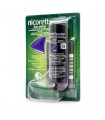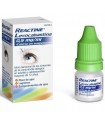ACTION AND MECHANISM
- [ANTI-SMOKING], [GANGLIOPLEJICO]. Nicotine is an agonist of nicotinic cholinergic receptors, mainly located in the autonomic nodes, adrenal marrow, neuromuscular plaque and central nervous system. The effects of nicotine on the body are multiple and varied, and depend on the dose administered and the vegetative tone of the person.
Nicotine is also responsible for tobacco dependence on smokers, possibly by two mechanisms. At low doses it seems to have a stimulating effect on the cortex through the locus ceruleus, with increased cognitive and alertness. At higher doses it seems to result in a "reward effect" originating in the limbic system.
Sudden discontinuation of tobacco after a prolonged period of use results in characteristic withdrawal syndrome, including symptoms such as dysphoria, insomnia, irritability, anger, anxiety, difficulty concentration, agitation, bradycardia and increased appetite with weight gain. There is also a craving for nicotine.
The administration of nicotine by patches or gum exerts effects similar to that obtained from tobacco, and provides, to those wishing to quit smoking, the amount of nicotine sufficient to reduce the onset of withdrawal symptoms. The dose of nicotine is progressively reduced, until the body can do without it.
ELDERLY
No specific pharmacokinetic studies have been conducted in the elderly, but the adverse effects and relapse rate in patients over 60 years of age are similar to in young people. However, heart disease is often more common in these patients, and a slight increase in the incidence of asthenia, body aches and dizziness has been reported.
ADVICE TO THE PATIENT
- It is advisable to reduce doses progressively, to avoid a relapse.
- Nicotine-based preparations may cause dependence.
- It is advised to notify your doctor of any symptoms of overdose such as nausea, vomiting, diarrhea, dizziness, weakness or palpitations.
- If chest pain occurs, it is recommended to stop treatment and go to the doctor.
- Do not smoke during treatment, or combine gum or tablets with patches.
- If nicotine is given in nursing women, it should be done at least two hours before breastfeeding the child.
- Treatment periods greater than 6 months are not recommended.
- The medicinal product should not be left where it may be misused, handled or ingested by children, as it may cause severe toxicity which can become fatal.
CONTRAINDICATIONS
- Hypersensitivity to any component of the medicine.
- Non-smoking or occasional smokers.
PREGNANCY
Animal safety: In studies with monkeys, the administration of a bolus of 2 mg/kg intravenous nicotine has resulted in acidosis, hypoxia, hypercapnia and hypotension of the fetus. Uterine blood flow was reduced by 30% when administering an infusion of 0.1 mcg/kg/minute.
Human safety: Smoking during the last trimester in pregnant women can cause foetal damage, such as stunting, risk of miscarriage and increased perinatal mortality, although its teratogenic potential has not been clearly established. It has been found that tobacco can also reduce fetal breathing movements. These effects have also been seen with nicotine gum.
Therefore, the pregnant woman should be advised to quit smoking altogether before the third trimester of pregnancy. Due to the inherent risk also presented by nicotine substitute therapy administration, it is advised that educational and behavioral programs be used before starting this treatment.
However, in highly dependent pregnant women it may be necessary to resort to nicotine replacement therapy. This therapy presents lower risks than smoking, as the plasma concentrations of nicotine achieved are lower and there is also no exposure to polycyclic hydrocarbons and carbon monoxide.
Tobacco cessation, with or without nicotine replacement therapy, should not be undertaken individually by the patient, but as part of a medically supervised smoking cessation program.
In the third trimester, nicotine has hemodynamic effects, such as changes in fetal heart rate, that can affect the fetus near childbirth. Therefore, after the sixth month of pregnancy nicotine should only be used in pregnant smokers who have not managed to quit smoking in the third trimester, and always under medical supervision.
PHARMACOKINETICS
Oral, transdermal, nasal route:
- Absorption:
INDICATIONS
- [DEPENDENCE ON TOBACCO]. Adjuvant treatment in smoking cessation programs, with the aim of alleviating symptoms of nicotine withdrawal syndrome.
Although these products mimic the effects of tobacco, they should never be used as tobacco substitutes.
INTERACTIONS
Tobacco smoke appears to behave as an enzymatic inducing agent, probably due to polycyclic aromatic smoke hydrocarbons, generated during partial combustion of plant fiber, and perhaps nicotine. By inducing metabolism, mainly CYP1A2 isoenzyme of cytochrome P450, a decrease in pharmacological effects may occur. Similarly, by stopping smoking, plasma concentrations of drugs that are metabolned along this route can be increased, so sometimes toxic effects may occur. It may therefore be necessary to readjust the dosage of drugs such as oral anticoagulants, benzodiazepines that are metabolized in the liver, caffeine, chlorpromazine, dextropropoxyphene, estrogen, phenacetine, phenazone, flecainide, flufenazine, haloperidol, imipramine, lidocaine, olanzapine, pentazocin, ritonavir or teofilin.
Other reported effects of smoking include reduced diuretic response to furosemide, modification of the pharmacological effect of propranolol and altered response rates in the healing of ulcers with H2 antagonists.
In diabetic smoking patients there is a possibility of a decrease in the antidiabetic effect of insulin, probably due to increased levels of catecholamines, which oppose the hypoglycaemic action, and the difficulty of subcutaneous absorption of insulin by peripheral vasoconstriction. Smoking patients typically require a 15-30% higher dose to control their blood glucose levels. When quitting smoking, a decrease in insulin dose is usually necessary.
These enzyme inducing effects have not been observed when nicotine is administered in the form of preparations for smoking cessation, so a dosing adjustment of these drugs may be necessary.
Nicotine may interact with the following drugs:
- Adrenergic agonists and antagonists. Nicotine stimulates the adrenal production of cortisol and catecholamines, so it can modify the effects of adrenergic drugs. Similarly, the administration of a vasoconstrictor drug as an adrenergic agonist, or of a vasodilator, such as a beta-blocker, can alter transdermal absorption of nicotine.
- Bupropion. The efficacy and safety of the combination of bupropion with nicotine has not been studied. In fact, the use of nicotine was an exclusion criterion from the first clinical trials conducted with bupropion. Manufacturers of this drug have described a possible increased risk of hypertension, with 6.1% compared to 2.5% of bupropion alone.
However, limited clinical data indicate that combining bupropion with nicotine patches could achieve better outcomes when quitting smoking habit. If you decide to combine nicotine patches together with bupropion tablets, it is recommended to evaluate your blood pressure weekly for the risk of hypertensive crisis.
BREAST FEEDING
Nicotine and its metabolites are excreted with milk, for up to 2 hours after the last cigarette. The levels achieved in milk are 2.9 times higher than those of plasma. It should be noted that the amount of nicotine present in breast milk is lower in nicotine drug users than in smokers. Nicotine can be absorbed orally by the infant to a greater extent than in the adult, due to the immaturity of metabolic liver mechanisms and the consequent reduction of the first-step effect.
Lactation patients should be advised not to smoke or use nicotine to become unhabituted. However, in patients with high dependence who have not managed to quit smoking, the risk to the infant should be assessed when using nicotine, and compared to that of tobacco exposure.
If replacement therapy is followed, it is recommended to use only gum or tablets and administer them after breastfeeding the baby. It should take at least another two hours before the child is breastfed again.
A pregnant woman should never start a nicotine smoking cessation program without consulting her doctor.
CHILDREN
The safety and efficacy of nicotine preparations in children under 18 years of age have not been evaluated and is therefore not recommended for use.
Nicotine doses well tolerated by adult smokers during treatment can cause symptoms of severe and even lethal poisoning in young children. Patients should be warned that nicotine preparations should be handled with care and not stored or disposed of so that children can accidentally use or consume them.
RULES FOR PROPER ADMINISTRATION
The patient should stop smoking completely during nicotine treatment, due to the risk of adverse reactions to nicotine due to higher levels of nicotine in plasma. It is not recommended to combine patches with chewing gum or tablets in treatment.
DOSAGE
- Adults, transdermal:
PRECAUTIONS
- [RENAL INSUFFICIENCY]. Nicotine and its metabolites are eliminated by urine, so a decrease in renal functionality could lead to its accumulation. Because metabolites are also active, adverse reactions may occur. No significant differences in the incidence of adverse reactions have been reported in patients with mild or moderate renal impairment (CLcr between 30-90 ml/minute), but close monitoring of these patients is recommended. In patients with severe renal impairment (CLcr less than 30 ml/minute) safety and efficacy have not been evaluated and is therefore not recommended for use (see Contraindications).
- [HEPATIC INSUFFICIENCY]. Nicotine is extensively metabolized in the liver, so in case of liver failure a buildup of it could occur. Extreme caution is recommended in patients with mild or moderate hepatic impairment, monitoring for possible occurrence of adverse reactions. Safety and efficacy in patients with severe hepatic impairment have not been evaluated and is therefore not recommended for use (see Contraindications).
- Heart disease. Nicotine has cardiac stimulant and vasoconstrictor effects, so it can worsen cardiovascular functions. Occasionally cases of cardiovascular adverse reactions with nicotine have been reported. However, it appears that oral or transdermal nicotine administration does not appear to be related to a particularly significant risk of cardiovascular disease. Patients with heart disease should be advised to stop smoking, if possible, without nicotine replacement therapy. However, if this is not possible, it is recommended to properly assess the need for treatment, studying the benefits and risks, and extreme precautions in patients with [CARDIAC INSUFFICIENCY], [ISQUEMICA CARDIOPATIA] such as recent [ACUTE MYOCARDIAL INFARCTION] or [ANGINA DE PECHO], [CARDIAC ARRHYTHMIA], [ICTUS] and vasospastic diseases such as [OBLITERANT TROMBOANGEITIS], [PRINZMETAL ANGINA] or [SYNDROME DE RAYNAUD]. It is also recommended to exercise special caution in case of patients with [HIPERTENSION ARTERIAL], as nicotine may increase pressure. In the event that the patient experiences a worsening of any of these symptoms it is advisable to stop treatment (see Contraindications).
- [FEOCROMOCITOMA], [HYPERTIROIDISM] or any picture that may be worsened by catecholamines, such as [TYPE 1 DIABETES MELLITUS]. Nicotine stimulates the production and release of catecholamines in the adrenal marrow. This can lead to worsening symptoms such as pheochromocytoma, hyperthyroidism, or diabetes. In general, nicotine administration has fewer risks than continuing to smoke, but it is recommended to pre-evaluate the benefit-risk ratio in these patients.
- [PEPTICA ULCERA] and other inflammatory stomach processes, such as [GASTRITIS]. Nicotine delays the healing of gastroduodenal ulcerations, so it is recommended to use it in these patients only if the benefits outweigh the potential risks.
- Dependency. Any nicotine preparation presents a risk of producing dependence, although due to the lower plasma levels achieved, it is less likely than with tobacco itself. However, abrupt withdrawal from treatment can lead to withdrawal syndrome similar to that caused when smoking is quitting. For this reason, it is recommended to gradually discontinue nicotine administration, and not discontinue treatment until you have the relative certain life that withdrawal syndrome will not occur.
- [HYPERSENSITIVITY REACTIONS]. Caution in patients likely to develop [ANGIOEDEMA] or [URTICARIA].
ADVERSE REACTIONS
This medicine may cause adverse reactions that are related to the pharmacological effects of nicotine or to withdrawal effects related to smoking cessation. Certain symptoms reported such as depression, irritability, nervousness, restlessness, moodiness, anxiety, drowsiness, loss of concentration, insomnia and sleep disturbances may be related to withdrawal syndrome associated with smoking cessation.
The most common adverse reactions of patches are those that take place at the site of application, including transient rash, itching, burning sensation, anting, insensitivity, swelling, pain and hives. Most of these topical reactions are minor and resolve quickly by removing the patch. Pain or feeling heaviness has been reported in the limbs or area around where the patch is applied (e.g. torax). Hypersensitivity reactions, including contact dermatitis and allergic reactions, have been reported. In the case of severe or persistent local reactions at the site of application (e.g. severe erythema, itching or edema) or generalized skin reactions (e.g. hives, or generalized rash), patients should discontinue the use of patches and consult the doctor. The dose of this medicine should be reduced or discontinued if there is a clinically significant increase in cardiovascular effects or other effects attributed to nicotine.
The most characteristic adverse reactions are:
- Digestives: Normal (20-40%) [DISPEPSIA], [NAUSEAS], [VOMITOS] or [GASTRIC HYPERACIDEZ]. Less common is the appearance of [MOUTH DRYNESS], [ANOREXIA], [DIARREA], [CLOSE], [ABDOMINAL PAIN], [FLATULENCE] or [HIPO].
Gum can also produce [HYPERSALIVATION], symptoms of inflammation of the oral cavity, such as [STOMATITIS], [GLOSITIS], [PERIODONTITIS], [FARINGITIS], [ESOFAGITIS] and pain in the jaw muscles, due to its high viscosity. These adverse reactions appear at the beginning of treatment, and may be reduced with proper administration of gum.
- Neurological/psychological. Common (1-25%) [DIZZINESS] (3-9%), [CEFALEA] (17-29%), [INSOMNIO] (3-23%), [DISMINUTION OF CONCENTRATION] (1-3%) (e) [IRRITABILITY]. Rarely (<1%) [EUFORIA], [SOMNOLENCIA], [CONFUSION], [DEPRESION], [PARESTESIA] and [CONVULSIONES] have been described. [TABACO DEPENDENCE] syndrome may occur if the withdrawal is abrupt or premature.
- Cardiovascular. Cases of [ARTERIAL HYPERTENSITENSION] and [EDEMA] have been reported. Occasionally (1-0.1%) [PALPIITATIONS] can occur, and more rarely (<0.1%) [CARDIAC ARRHYTHMIA]. Some cases of [ACUTE MYOCARDIAL INFARCTION], [ATRIAL FIBRILACION] and [ICTUS] have been reported in patients treated with nicotine patches. However, a causal link could not be established with nicotine.
- Respiratory. Some cases of [TOS] (3-9%), chest congestion and [DYSPNO] have been reported.
Nicotine administered nasally may result in local irritation phenomena, such as [NASAL CONGESTION], [SNEEZING], mucosal irritation, [FARINGITIS], [SINUSITIS], [EPISTAXIS], [CONJUNTIVITIS], [DISGEUSIA] and [PAROSMIA]. These effects appear very frequently (94%) at the beginning of treatment, but are reduced with continued use.
- Allergic/dermatological. Nicotine can result in [HYPERSENSITIVITY REACTIONS], with itching and erythema, and even [ANGIOEDEMA].
Patches have resulted in local reactions in certain people, such as [ERYTHEMA] (14-17%), which disappeared at 24 hours, localized oedema (3-4%), [PRURITO], burning sensation in the application area (35-47%), [CONTACT DERMATITIS] (2-3%) and [VASCULITIS]. In case of serious adverse reactions, such as [DERMATITIS] (1-7%) or generalized dermatological reactions such as erythema or severe injuries, it is recommended to discontinue treatment. Administration of topical corticosteroids and/or oral antihistamines has been shown to be effective in reversing these symptoms.
- Osteomusculars. Patches have sometimes resulted in [MIALGIA] and [OSTEOMUSCULAR PAIN] (3-9%).
- Generals. Some cases of [TORACIC PAIN], [ASTENIA], [BACK PAIN] or [HYPERHIDROSIS] have been reported.
OVERDOSE
Symptoms: Nicotine is a very toxic substance, and doses of 0.6-0.9 mg/kg can be lethal in humans. However, there is great interindividual variability, as chronic smokers can tolerate higher doses than children and non-smokers, due to the development of tolerance. In children, a small dose of nicotine can be dangerous and lead to serious and even fatal symptoms, so it is recommended that these medicines be out of reach of children and that in case of suspected poisoning, a doctor should be consulted immediately.
Despite the high toxicity of nicotine, very little data are available on nicotine poisoning. Poisoning can occur if multiple gums are chewed at once, multiple tablets are sucked, several patches are given, or if these devices are combined with each other or with tobacco.
In case of ingestion of nicotine, the risk of overdose is low, as it is slowly released in small amounts, and is inactivated by a first-step effect. In addition, vomiting usually occurs quickly, preventing nicotine absorption.
In general, nicotine poisoning results in the same symptoms as excessive tobacco use. However, it should be noted that tobacco smoke contains other toxic substances such as tar and carbon monoxide. General symptoms of poisoning include nausea, vomiting, diarrhea, abdominal pain, headache, nervousness, irritability, insomnia, dizziness, tachycardia and palpitations, hypertension or hypotension, QT interval extension, paleness, muscle weakness, sweating, excess salivation, burning of the throat, eye and ear disturbances, dyspnoea. In the most severe tables, lethargy, circulatory collapse, seizures, coma and death from central or peripheral respiratory paralysis or sometimes heart failure may occur.
Treatment:




























